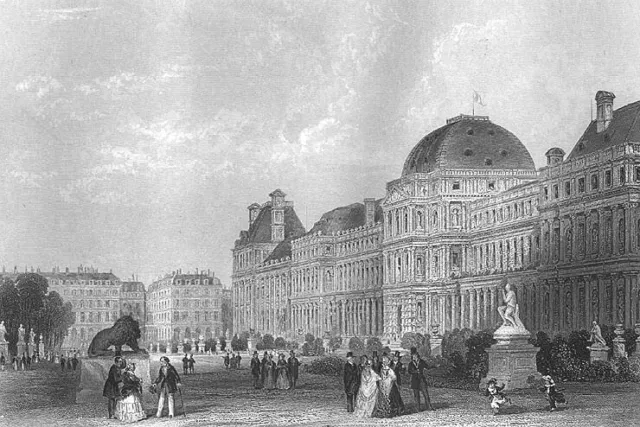Paris COMMUNE 1871 BURNED DOWN TUILERIES PALACE ~ 1865 Art Print Engraving RARE!
PALACE OF THE TUILERIES Artist: T. Allom ____________ Engraver: W. Floyd |
VERY OLD WORLD! INCREDIBLE DETAIL!
History: After the death of Henry the Second in 1559, his widow, Catherine de Médici, (1519-89) planned a new palace. Catherine de Medicis began the building of the palace of Tuileries in 1564. The name derives from the tile kilns or tuileries which previously occupied the site. The original architect was Philibert de l'Orme. The building was greatly enlarged in the 1600's. The palace was formed by a series of long, narrow buildings with high roofs that created one major and two minor courtyards. Tuileries stood on the right bank of the River Seine in Paris. The southeast corner of Tuileries joined the Louvre. The great Louis XIV resided at the Tuileries Palace while Versailles was under construction. When he left, the building was virtually abandoned. It was used only as a theater. During the French Revolution, mobs forced Louis XVI and his family to live there under house arrest. For a time, the National Convention held its sessions in the Tuileries. When Napoleon I came into power he made Tuileries his home.
As Napoleon's chief residence Tuileries Palace was redecorated in the Empire Neoclassical style by some of the best known architects, designers, and furniture makers of the day. Pierre François Léonard Fontaine and Charles Percier, the two most fashionable architects of the day, reappointed the palaces of the Louvre and the Tuileries in the period 1802-12. One of the artist Pierre Paul Prud'hon's (1758-1823) most splendid commissions was to design the apartments of the new empress, Marie-Louise, in Tuileries Palace. For the bridal suite of the Empress Marie-Louise he designed all the furniture and interior decorations in a Greek Revival style. In 1809, Jacob-Desmalter, principal supplier of furniture to the Emperor, began work on a jewel cabinet designed for the Empress Joséphine's great bedroom in the Tuileries (and soon to be used by Marie-Louise). This impressive piece of furniture which was designed by the architect Charles Percier is embellished with several bronze ornaments: the central panel depicts the "Birth of the Queen of the Earth to whom Cupids and Goddesses hasten with their Offerings" by Pierre-Philippe Thomire, after a sculpture by Chaudet. Jacob-Desmalter completed the "great jewelry box" in 1812, with two smaller items of furniture in the same style but using indigenous woods. Tuileries Palace served as the royal residence after the Restoration. Supporters of the Commune destroyed most of the palace in 1871, but the gardens west of the palace remain. These gardens, covering about 63 acres (25 hectares), still closely follow a design laid out by landscape architect Andre Le Notre in 1664. His spacious formal garden plan drew out the perspective from the reflecting pools one to the other in an unbroken vista that lent the garden a sense of grandeur.
FROM THE ORIGINAL DESCRIPTION: The palace of the Tuileries is one of the noblest structures in the French capital. It occupies the site of some file-fields, which in the days of Charles VI. had furnished Paris for four centuries with the material necessary for building purposes. The word Tuileries signifies tile-kilns) and may, therefore, be taken as conclusive as to the purposes to which the ground upon which the palace now stands was applied. Externally, it appears to us a somewhat sombre building, although we are surveying it under the aspect of what would, in England, be called "a fine day." It is, while we gaze upon it, destitute of the imperial splendour which was wont to grace the residence of the third Napoleon. Alas! with what a sudden Protean power political transformations are effected in France! But let us proceed. From its very foundation by Gatharme de Medicis in 1564, the Tuileries has been intimately associated with some of the darkest passages in Parisian annals. It was not long the residence of Gatharine, whose superstition was such as to frighten her from it. One of her astrologers having predicted that she would die near St. Germain, amid the ruins of an old house, sent her from the proximity of St. Germain FAuxerrois to the Hotel de Soissons, but she did not escape the supposed verification of the prediction, as she died at Blois, in the arms of a priest of the name of St. Germain, immediately after the murder of the Duke of Guise-thus figuratively expiring amid the ruins of an old house, Louis XIII. made it the palace of his capital, and Louis XIV. resided here till Versailles was habitable, when the court forsook Paris, and the Tuileries became the abode of official persons. Of Louis XVI. it was the prison in 1789, and the bloody days of the Revolution connect it with gloomy associations. Under the first republic it was called the Palais National, and the sittings of the Convention were held in it. Here the sentence which deprived Louis XVI. of his head was pronounced; but notwithstanding its previous history, it became the palace of the first Napoleon as consul and emperor. After the Restoration it was occupied by the Bourbons; but in 1830, Charles X. was driven from it by the people. In 1848, Louis Philippe, with several members of his family, escaped from it by the broad gravel-walk which runs down the centre of the gardens to the Place de la Concorde. Here he obtained a vehicle, and passed through the very crowd that were pressing into the palace. It was now held by the citizens for many weeks, but at last was cleared out, and under the new republic was used for a picture exhibition. It was afterwards inhabited by Napoleon III., who greatly improved and embellished it. Connected with it are beautiful gardens, terraces, and walks, profusely adorned with vases and classical subjects in statuary.
The engraving which we give of the Tuileries is not only beautiful in itself, but masterly as a work of correct representation in art. Let the reader, then, whilst viewing this, imagine the following scenes in succession, as he may suppose them to have taken place in the palace at the time we speak of. In the death of Mandat the court lost its most resolute and influential defender. His presence, and the order he had received to employ force in case of need, were necessary to induce the National Guard to fight. The appearance of the nobles and the royalists had greatly cooled their enthusiasm. Metaphorically speaking, it seems to "us to have been something like throwing a wet blanket over a person in a state of perspiration. Mandat himself, before his departure, had entreated the queen to dismiss the troop, which was regarded as a troop of aristocrats; but she replied, with austerity, "These gentlemen are come to defend us, and we count upon them." Alas! how vain the defence of a stationary few against a momentarily-increasing multitude!
ABOUT THE ARTIST: Thomas Allom (1804-1872) was born in London, England on 13th March 1804. He was articled to Francis Goodwin, an architect in 1819. He was to become a founder member of the R.I.B.A. (Royal Institute of British Architects - which is still the premier institution today). He is best know for his topographical drawings, so many of which were engraved on steel & appeared in many of the travel books of the time. He travelled extensively, not just in the UK & Europe, but further afield, covering such countries as Turkey & China. Collections of his work can be found in the British Museum and the Victoria & Albert Museum.
Please note: the terms used in our auctions for engraving, heliogravure, lithograph, print, plate, photogravure etc. are ALL prints on paper, NOT blocks of steel or wood. "ENGRAVINGS", the term commonly used for these paper prints, were the most common method in the 1700s and 1800s for illustrating old books, and these paper prints or "engravings" were inserted into the book with a tissue guard frontis, usually on much thicker quality rag stock paper, although many were also printed and issued as loose stand alone prints. So this auction is for an antique paper print(s), probably from an old book, of very high quality and usually on very thick rag stock paper.
- Type: Print
- Date of Creation: 1800-1899
- Material: Engraving
- Original/Licensed Reprint: Original
PicClick Insights - Paris COMMUNE 1871 BURNED DOWN TUILERIES PALACE ~ 1865 Art Print Engraving RARE! PicClick Exclusive
- Popularity - 0 watchers, 0.0 new watchers per day, 514 days for sale on eBay. 0 sold, 1 available.
- Best Price -
- Seller - 23,187+ items sold. 0.4% negative feedback. Great seller with very good positive feedback and over 50 ratings.
People Also Loved PicClick Exclusive
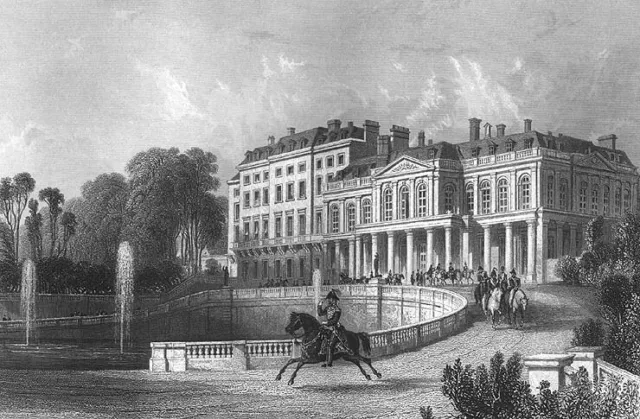
France, CHATEAU DE SAINT CLOUD Destroyed in War ~ 1865 Art Print Engraving RARE!
$37.99 Buy It Now 3d 16h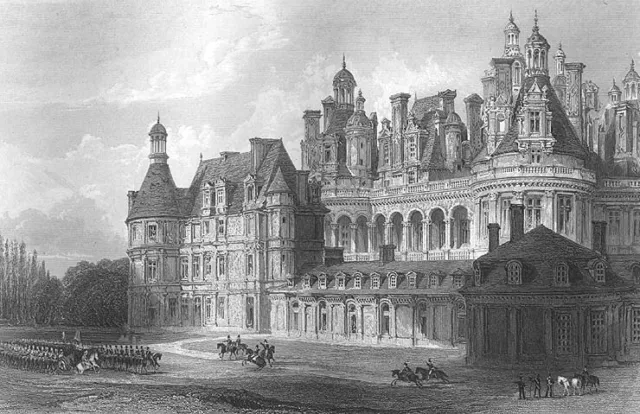
Blois CHATEAU DE CHAMBORD ~ 1865 Renaissance Architecture Print Engraving RARE!
$44.99 Buy It Now 3d 16h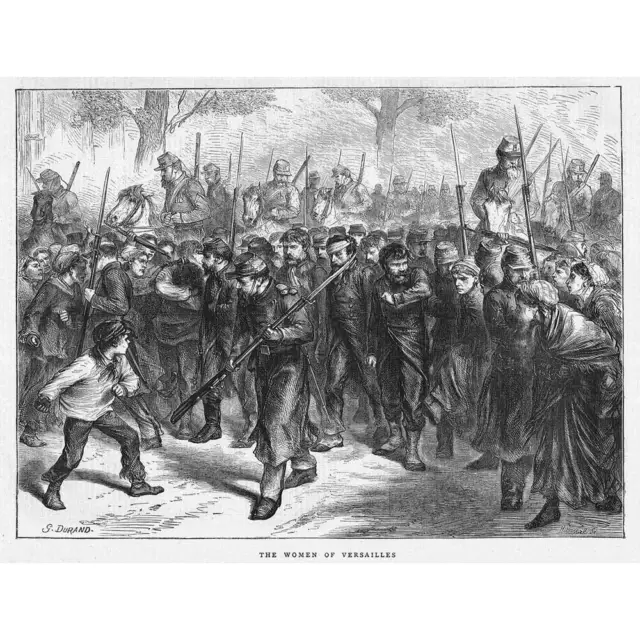
PARIS Commune: The Women of Versailles - Antique Print 1871
$17.42 Buy It Now 24d 16h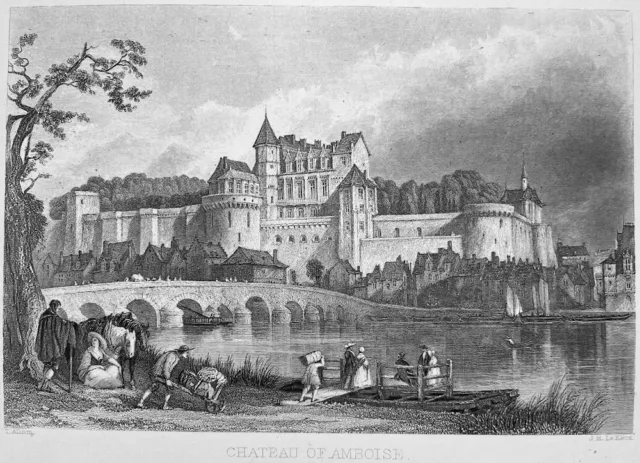
France, LOIRE CHATEAU D’AMBOISE GOTHIC ARCHITECTURE ~ 1869 Art Print Engraving
$19.99 Buy It Now 13d 21h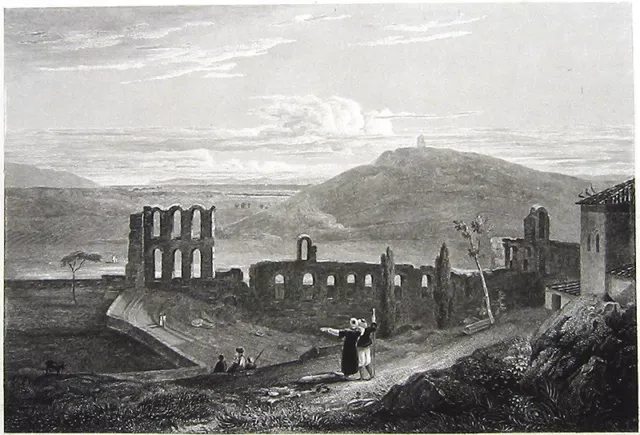
Athens Greece ODEON OF HERODES ATTICUS Stone Theater ~ 1829 Art Print Engraving
$24.99 Buy It Now 2d 23h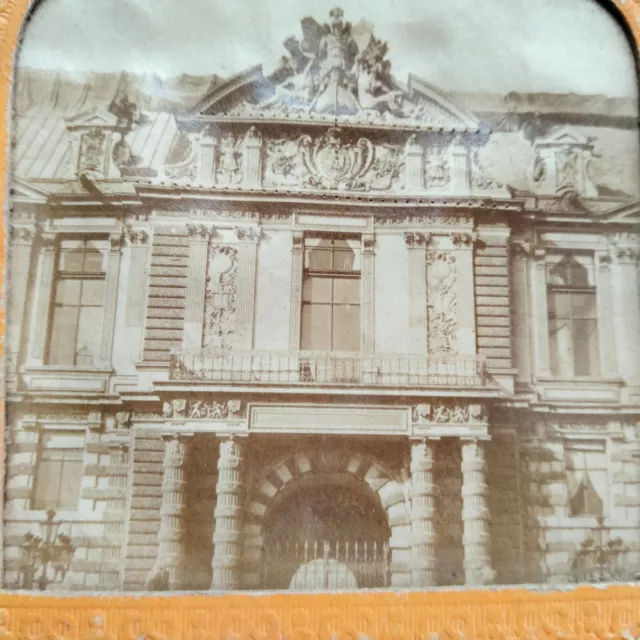
 Palace Of Tuileries Burned IN 1871 Commune Of Paris Photo Stereo Albumin$36.71 Buy It Now
Palace Of Tuileries Burned IN 1871 Commune Of Paris Photo Stereo Albumin$36.71 Buy It Now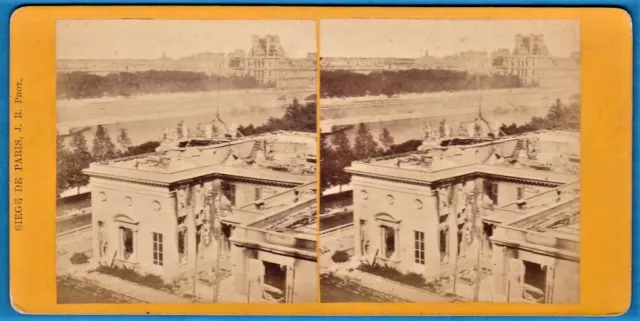
 stereoview photo burned Legion d Honneur palace Commune Paris France stereo 1871
stereoview photo burned Legion d Honneur palace Commune Paris France stereo 1871$33.83$25.03 Buy It Now or Best Offer
 Palace Of Tuileries Burned IN 1871 Commune Of Paris Photo Stereo Albumin$36.86 Buy It Now
Palace Of Tuileries Burned IN 1871 Commune Of Paris Photo Stereo Albumin$36.86 Buy It Now
 Palace Of Tuileries Burned IN 1871 Commune Of Paris Photo Stereo Albumin$36.74 Buy It Now
Palace Of Tuileries Burned IN 1871 Commune Of Paris Photo Stereo Albumin$36.74 Buy It Now
